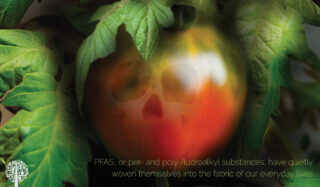What Are PFAS And What Harm Can They Cause To Your Garden?
You may have noticed the mysterious acronym floating around, whether scrolling through your newsfeed or listening to current events. PFAS, or per- and poly-fluoroalkyl substances, have quietly woven themselves into the fabric of our everyday lives. While lead contamination and ongoing microplastic concerns have held the spotlight over the years, PFAS have stealthily crept into the narrative, and their effects are becoming more apparent as ongoing research begins to bear fruit. These unsettling consequences have unfolded since the 1930s when PFAS chemicals were invented and the rise of nonstick products started. Found in common items like food packaging, stain-proof rugs, waterproof clothing, nonstick cookware, and even firefighting foam, these substances have become pervasive and under-regulated in our environment, and they’re not going anywhere in our lifetime until researchers can reliably remove them.
The Rise of PFAS
Dubbed ‘forever chemicals,’ PFAS are a large group of substances that earned this nickname due to their stubborn, long-lasting nature in the environment and our bodies. Composed of strongly-bonded carbon and fluorine atoms that resist easy degradation, some forms of PFAS can take over 1,000 years to break down in nature and around seven to reduce by half in our bloodstream. They travel freely through various channels, including the atmosphere, surface water, soil, and groundwater.
A staggering 98% of Americans have detectable levels of PFAS in their blood. There’s been “some sort of statistical association between PFAS and every major organ system in the body”, according to Elsie Sunderland, associate professor of environmental science and engineering in the Department of Environmental Health at Harvard T.H. Chan School of Public Health. PFAS are linked to asthma, high cholesterol, immune suppression, thyroid diseases, liver and kidney damage, certain types of cancer, reduced fertility, and low birth weight. But this is just the beginning; ongoing research continues to uncover more.
Although they have been measured in air and dust particles, PFAS primarily enter our bodies when we eat and drink from contaminated sources. The substances can wind up in food in many ways, from leaching off paper and plastic food packaging to infiltrating the soil.
According to the Wisconsin Department of Health Services, studies have demonstrated that PFAS can be taken up by plants from contaminated soil and irrigation water; the amount that ends up in a particular plant depends on a few factors, including soil properties, produce type, water frequency, and PFAS levels in the water and soil itself.


The Gardener’s Dilemma: Are PFAS Safe For My Garden?
So, as we grapple with the ubiquity of PFAS, a pressing question arises for every gardener: how can we shield our gardens and bodies from these forever chemicals?
The good news is that there are many steps you can take, and simple yet effective measures can make a significant impact. Washing all produce in clean water and peeling or scrubbing root vegetables before eating can remove PFAS lingering on the surface. Adding high organic carbon sources like compost, peat, and manure that do not contain PFAS to garden soil has also been reported to reduce plant uptake.
However, these precautions don’t consider one of the primary sources of PFAS: water. Watering your garden with PFAS-laden water perpetuates the problem and exacerbates it as you inadvertently reintroduce these persistent chemicals into the ecosystem you seek to protect. Switching to filtered water, or water from another safe source, is the most effective option to mitigate PFAS exposure in your garden. While activated carbon filters, on average, remove just 73% of PFAS, researchers at Duke University and North Carolina State University found that reverse osmosis filters and two-stage filters using a treatment train reduced PFAS by 94% or more. Depending on budget and availability, any filtration method offers a significant improvement over having no system in place.
If you’re highly concerned about PFAS contamination in your area, you may want to consider adopting an alternative gardening practice altogether. Hydroponic gardening with filtered water eliminates the risk of PFAS in your soil, allowing for precise control over every aspect of your garden. A controlled indoor gardening environment, such as greenhouse growing, may also offer better protection against pollutants.
Hope for the Future: What is in store for PFAS?
With the effects of PFAS only recently yielding results, the current regulatory landscape is consequentially patchwork, with varying levels of oversight across different regions. While some areas have established limits and guidelines for PFAS concentrations in water and soil, others are still formulating comprehensive regulations. In 2023, the EPA proposed the first federal drinking water rule for PFAS. The EPA “will require public water systems to monitor for six PFAS chemicals, notify the public if the levels of these PFAS exceed the proposed regulatory standards, and take action to reduce the level of PFAS in the water supply.”
Other highlights include:
● Measuring and monitoring of PFAS in population blood, food, and marine life
● Accelerating PFAS cleanup from the environment
● Strengthening policy and reducing the procurement of PFAS
● Expanding programs and resources
● Closing critical research gaps in PFAS detection, disposal, health effects, and
PFAS-alternatives
● Bolstering community engagement and information sharing.
These updated guidelines are being implemented specifically within the United States. Globally, the regulation of PFAS varies. Health Canada has established guidelines for PFAS in drinking water, and the European Union has imposed restrictions and outright bans on certain PFAS. In Australia, the government has launched a voluntary phase-out program for some PFAS and has restricted their use of firefighting foam. The promise of a PFAS-free tomorrow hinges upon progress in measuring, monitoring, and cleanup. As research broadens and community awareness grows, the hope is that regulatory frameworks will strengthen and PFAS will be systematically controlled and eradicated.
Addressing the presence of PFAS in our gardens and remaining aware of their impact is
not just a matter of environmental responsibility but a crucial step towards safeguarding our health and the well-being of future generations. While we await the integration of broader safety measures, the reinforcement of established laws, and the widespread removal of contaminants from the environment, we can play a pivotal role by taking proactive steps to mitigate PFAS exposure.





